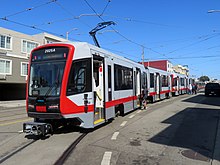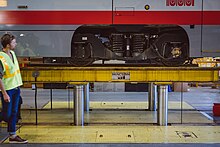Siemens S200
Siemens entered the North American light rail market in the late 1970s with the Siemens–Duewag U2, which was initially built in Düsseldorf, West Germany.
[3] Calgary Transit selected Siemens to manufacture 60 light rail vehicles in 2013, to replace part of its initial fleet of U2 trains.
[5] The second customer, the San Francisco Municipal Railway, uses a combination of high platforms and street-level stops for its Muni Metro system.
This distinct environment prompted the inclusion of retractable stairs in San Francisco's S200 trains, which entered service in 2017.
The design is customized for each operator, to account for varying platform heights, loading gauges, and service requirements.
Heated floors and triple-pane windows were added to combat Calgary's harsh winter climate, as well as sloped entryways to eliminate moving ramps found on older trains.
New infotainment systems were added alongside LED info signs to display next stop and line information.
[18] GCRTA's S200 vehicles will include steps at the front and back doors for boarding and alighting at street-level light rail stations and stops.
[20] The plan was first announced in January 2023, and the deal was finalized in May 2023, after the RTA received a grant from the Federal Transit Administration.
[24][25][26] The S200 vehicles for St. Louis will be equipped with batteries for operation on tracks without overhead lines, allowing for flexibility in future expansions.
The issues with the LRV4 fleet, combined with the high failure rate of SFMTA's older trains, caused delays and overcrowding on multiple services.
[29] As a temporary measure, the rear doors on S200 trains were locked shut to prevent additional trapped passengers.
[31]In a separate incident on April 12th, a two-car train of LRV4 cars was found with a faulty shear pin in its couplers.
[32] At the Board of Supervisors meeting in April 2019, Muni officials also reported that the wheels on the LRV4s required resurfacing before their expected end-of-life because of the use of emergency brakes, which are engaged once a week on average.
[35] The later issues with shear pins were attributed to stresses on the couplers brought on by San Francisco's hilly terrain.
Software glitches in some newly-introduced S200 trains activated a safety mode, which reduced their service speed from 80 to 40 km/h (50 to 25 mph).
Calgary Transit officials highlighted their maintenance and inspection procedures, and emphasized that their trains' doors are built to a different specification than in San Francisco's fleet.



